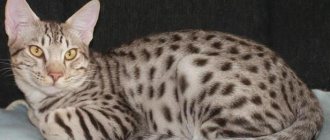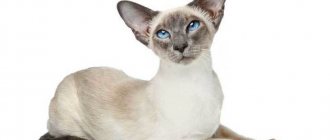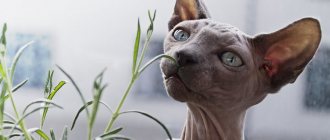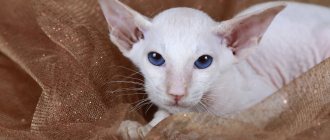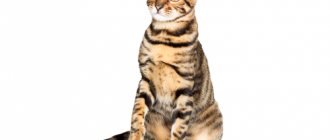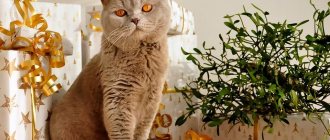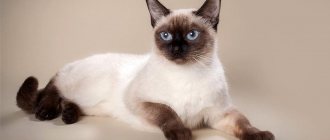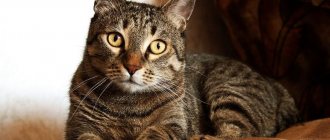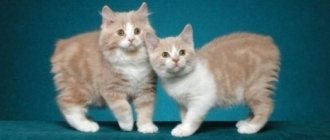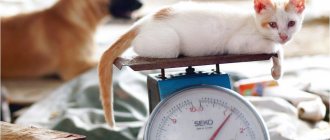The Abyssinian cat is a devoted friend, with a character that simultaneously resembles both a cat and a dog. They are very inquisitive and follow their owner with great interest, wanting to help him in all his worries. Royal exterior, predatory grace and a kind, loving heart - this is the shortest and most accurate description of Abyssinian cats.
What surprises has this breed prepared for us? Is it difficult to maintain them? What should you prepare for when buying an Abyssinian cat? In this article you will find answers to these and many other questions.
Key facts
The Abyssinian cat belongs to the ancient breeds of the cat family. The country of origin of the animals is called Ethiopia, which at that time was called Abyssinia, hence the name. The description of the Abyssinian cat breed includes abbreviated names - Abyssinian/Abyssinian, or Abi.
Medium-sized Abyssinian cats are considered very active, energetic individuals. Indeed, lying on the sofa or purring in the arms of the owner does not suit them. They are ready to run and play all day long. They maintain this rhythm of life until old age. The life expectancy of Abyssinian cats is long, 15-17 years, and there are even centenarians who live up to 20 years.
The main characteristic of the Abyssinian cat that sets it apart from others is its amazing coat color. Only by this can one unmistakably identify the Ethiopian breed.
Ancestors and relatives
The ancestors of the Abyssinians were most likely wild inhabitants of North Africa and Ethiopia. At the very least, Libyan and North African wild cats closely resemble this breed.
Wild cat wines such as the marsh lynx and the jungle cat are very similar to the Abyssinians.
History of the origin of Abyssinian cats
The Abyssinian cat became popular in ancient times. However, the time and place of its origin have not yet been precisely established. There are several main versions.
According to the first version, the animals entered Europe after 1868, when the war between England and Abyssinia ended. As proof of this theory, a book was presented in which a picture was found of a cat named Zulu, brought after this military campaign by Captain Barrett-Lenard. Apart from this drawing, no other evidence of this point of view was found.
Other breeding scientists call Ancient Egypt the country of origin of the Abyssinians. They showed figurines of cats similar to this breed.
Also, a genetic study carried out in parallel established their relationship with individuals living on the shores of the Indian Ocean. However, the only thing that debaters agree on is that the ancient branch of the breed is extinct.
Modern pets appeared in 1871 at an exhibition in England, where the jury members liked their appearance and habits so much that they were able to win 3rd place out of 170.
In 1882, breeders recorded a detailed description of the breed, in 1889 the first standards appeared, and in 1896 the Abyssinian breed was officially recognized with the assignment of a number and entry into a special stud book.
At the beginning of the 20th century, these animals crossed the ocean and became popular in the USA and South America. This helped save the breed from complete destruction in the post-war years. In the middle of the last century, after the end of World War II, no more than a dozen pets remained in Great Britain. Thanks to American individuals, the breed was restored. However, breeders still talk about two branches of the breed: American and European. This was due to minor changes made by breeders to the appearance of cats during their stay in the United States of America.
Pedigree cats appeared in Australia and New Zealand in the 1950s. There they gained enormous popularity. Until now, the Abi is considered the most numerous short-haired breed in these countries.
In 1994, breeder P. Khudyakova brought an Abi cat with a blue teak shade from Europe to Russia. But the impetus for breeding the breed in our country was given by a wild-colored Abyssinian named Florence, exported from Holland by breeder E. Kovalenko. In 1998, a fawn-colored cat was brought from the USA, and in 2000, N. Tyrdanova got a blue pet. From that moment on, abi began to gain popularity in our country.
Unfortunately, in Russia these cats still remain small in number, as they are considered exotic. And in Western Europe and America, according to a 2012 study, Abyssinians rank second in popularity.
Breeding Abyssinians
You can buy a kitten only at 3 months of age. By this age, breeders accustom kittens to the litter box, give them their first vaccinations, and genetic abnormalities also become visible. Reviews advise contacting a large, well-known nursery, or trusted breeders.
It is advisable to take medical certificates confirming the pet’s health and pedigree, which will show the absence of inbreeding.
Important!
When purchasing, it is important to pay attention to the kitten's nose, eyes and ears. There should be no stains, discharge, or mucus. The gait should be balanced. The Abyssinian cat should not be shy.
The Abyssinian cat ceases to be a kitten at 8-9 months of age. Males are considered mature at the same age. It is recommended to introduce cats to a male cat after the first 3 heats. The female is always brought to the male’s territory and left there for several days. It is worth considering that infertile individuals are often found among cats.
Abyssinians have a developed parental instinct. Cats easily take care of their offspring just as well as a mother cat.
Interesting!
Abyssinian boys are born 4 times more often than girls, which makes the cost of a girl even higher.
Similar cat breeds
Burmese cat
Bengal cat
Oriental cat
What does an Abyssinian cat look like?
Muzzle
The wedge-shaped shape of the animal's head is very proportional and does not have pronounced protrusions or flat areas. The back of the head smoothly passes into the neck. Nose length is average. It is softly connected to the forehead line. The rounded chin is hard and well developed. The breed standard allows for the appearance of clearly defined cheeks in adult males, but a muzzle pointed at the end is considered unacceptable.
What does an Abyssinian cat look like in general? This is an elegant animal with an unusual and very attractive color. From the photo of the Abyssinian cat you can see that it is distinguished by strong bones and pleasant-to-touch fur.
The eyes of cats are very beautiful almond-shaped. They are large, set wide apart from each other with a slight slope. The round shape is a deviation from the standard. Eye color has many variations: from light amber to green. Regardless of the shade, there is a black border around the eye.
The Abyssinian's ears give her a slightly alert appearance due to their forward tilt. They are large in size and located far from each other. Towards the tips the ears narrow and slightly rounded, but towards the base of the head, on the contrary, they widen. The skin of the ears is covered with very short hair with a bald spot in the middle.
Body type
Strong and very flexible, the Abyssinian breed has a medium body size. Males are somewhat larger than cats, but this is not too clearly expressed. Their weight ranges from 3-4.5 kg. In its structure, the body of the animals resembles small pumas due to its elegant silhouette and grace. It is noted that the American branch of cats has a lighter and more graceful body than the European one.
The body of the Abyssinian is moderately elongated, very flexible and proportional. Despite the well-developed muscles, it does not look rough. The chest has a rounded shape, a slight deflection is noticeable on the back.
The cat's thin, fairly long paws are very strong. Well-developed muscles allow them to jump a distance of 6 times their own length. On the oval-shaped paws, small toes are visible tightly pressed to each other; it seems that the cat is stretching on tiptoe. The tail is thin, rather long, strongly tapered at the end.
Coat and color
The coat of cats is short and quite elastic. According to standards, hair should be shiny, with a ticking tint. The fur adheres closely to the body of the animal. The undercoat is small but very dense.
A distinctive feature of the color of the Abyssinian cat is considered to be a warm, rich color without any pattern with a characteristic iridescence. This effect is possible thanks to ticking, that is, stripes of several shades from light to dark on each hair.
On the soles of the paws, back, and tip of the tail, the color is more saturated, dark, but the inner surface of the hind and forelimbs, chest, and belly are presented in light shades.
There are 4 colors that are characteristic of the breed:
- wild, or ruddy - brown-orange color;
- Sorel is a rich red shade with a red or orange tint;
- blue – gray-blue color with a reddish tint;
- faun is a delicate creamy red shade.
In addition, we can talk about 4 more varieties of Abyssinian cat in color, which are characterized by an attractive silver-metallic shade: silver fawn, silver blue, silver sorel and silver ruddy. Pets of this color most often have greenish-blue eyes.
According to the standards, white specks all over the body or a white spot on the chest are considered incorrect. Such animals are not allowed for exhibitions or shows.
Features of color
Abyssinian cats are found in four shades of fur:
- blue;
- wild (orange-brown);
- sorrel (copper-honey);
- faun (light beige).
The Abyssinian's coat is thick, with thin hairs that lie tightly to the body. All colors of Abyssinian cats are characterized by ticking - dyeing each hair in three colors. This gives the cat's coat an exquisite shimmer.
Character of the Abyssinian cat
Animals of this breed are very inquisitive, active and playful. Moreover, they retain these qualities throughout their long lives.
The exotic, even slightly wild appearance of cats attracts lovers from all over the world. However, we should not forget about the poise, intelligence and high intelligence of animals.
Abyssinians love all family members, but they have only one owner. They are patient with children, ready to play with them without releasing their claws. Experienced owners know that by allowing a small family member to play with the cat, they can be sure of the child’s safety.
Animals like to keep everything under control: they walk around the apartment in search of something interesting, and enjoy watching everything from the heights of cabinets or other furniture. They can easily tolerate being around other pets, will not conflict with dogs, and can even make friends with a hamster.
The neatness of pets is manifested in the fact that they do not create a mess in the house, will not dig the soil in pots or scratch furniture. But you need to take care of the cat's comfort. For example, buy a special scratching post. But it’s better not to forget to close the windows, otherwise the pet will arrange an independent walk.
The character of the Abyssinian cat can be traced to the behavior of dogs. They are happy to bring items abandoned by the owner and will not constantly sit on laps or sleep on the sofa. Their devotion to humans is very developed, so leaving a pet without attention will be quite cruel.
Rays of the sun
A distinctive feature of this breed is its very unusual coat. Because of this, the Abyssinian cat is also called the sun cat or the rabbit cat. Its soft, short, but silky fur resembles that of a rabbit.
The color of the cat's coat is also very unusual. Each hair is evenly colored with dark and light stripes, reminiscent of the sun's rays.
This color is called ticking. The skin looks simply gorgeous - it shimmers in the sun and simply shines dazzlingly.
Raising an Abyssinian cat
Representatives of the Abyssinian breed are very smart, so they do not have any difficulties with the learning process. If an animal lives in a family, then its socialization occurs quite quickly.
The ability to remember allows you to develop many useful habits in your cat and accustom him to the rules of living in an apartment. Although, unlike many other cat breeds, Abyssins do not like to play pranks or misbehave. But they can learn to turn on the TV, computer and lift the hook to open the closet without human help.
You can train your kitten to use the toilet by showing him the litter box and making sure he uses it correctly the first time. Then the baby will cope on his own.
Owners describe cases when their pets easily remember and carry out simple commands and retrieve thrown objects. In general, raising an Abyssinian cat is easy, especially if the owner already has experience in keeping cats.
Looking for an Abyssinian cat? Find your pet from 2 offers As a gift
Cohabitation
It is difficult to predict how Abyssin will live with other pets. Usually this breed is very friendly to other cats and dogs; if the partner does not encroach on its territory, then everything will go smoothly.
But with birds and rodents everything will be much more complicated, since these animals will become just a new toy or object of hunting for a playful cat.
Abyssinian cat health
Possible diseases
Abyssinian cats are considered quite healthy. All their diseases are most often associated with poor nutrition or are hereditary.
Kidney amyloidosis is a common disease among the breed. There are symptoms that are a signal for an urgent visit to the veterinarian: rapid weight loss, persistent dental problems, frequent urination, vomiting.
Hereditary diseases that manifest themselves in adult animals include retinal atrophy. This is a progressive problem that causes your pet to refuse to enter dark rooms or go down stairs.
The following health problems in Abyssinians are associated with genetic predisposition:
- anemia, leading to a serious condition if there is no proper treatment;
- hip dysplasia;
- dislocations of the kneecap.
Skin diseases primarily include dermatitis and food allergies. Both of these diseases are not associated with heredity. Thus, dermatitis becomes a consequence of stress or overexcitation of the animal, which in a similar state begins to bite and lick the skin. Allergies arise due to improper, unbalanced nutrition. It can also lead to obesity that is dangerous to your pet’s health.
Reproductive health
Kittens become sexually mature by the age of one and a half years. Then it is recommended to look for a cat for mating. Only harmoniously developed and healthy individuals can produce offspring without genetic abnormalities.
Pregnancy and childbirth are usually easy. The appearance of kittens requires increased attention from the Abyssinian owner. It is important to provide them with a fairly large space for games and proper development.
Females are sterilized by 1 year, males are castrated by 6 months. Delayed operations may lead to complications. This is due to the fact that the health of an Abyssinian cat directly depends on its age.
Abyssinian grooming
If your Abyssinian pet does not participate in shows or exhibitions, then caring for its appearance will not cause much trouble. However, you will have to regularly take care of your hair, ears, eyes and paws, and costs for the necessary hygiene are expected.
What you need for hair care
As a smooth-haired and clean-loving breed, a healthy Abyssinian cat manages to maintain its coat mostly on its own, even when shedding. She does not need a haircut a priori, and combing her fur should not be done more than 2 times a month. Neither the formation of mats nor skin diseases are typical for the breed. You need to apply the shine with a special brush, starting combing with movements against the fur in order to rid the undercoat of fallen hairs. After combing along the fur, you need to remove the hairs with a special rough glove.
Bathhouse for a cat
The Abyssinian refutes the saying “a cat is afraid of water.” If desired, she can jump into her owners’ warm bath, but she should not be allowed, since hot water and “human” detergents are contraindicated. To avoid allergies, you need to buy special cat shampoos balanced in alkali concentration without conditioner.
It is necessary to accustom him to a bath with warm water from a young age, preferably after trimming his claws. It is better to plan water treatments during shedding - the hair that climbs will be washed off. After bathing, you need to dry the animal well. Abyssinians usually don't mind the blast of warm air from a hairdryer.
Other necessary grooming
In the periods between baths, after dusty walks, coarse grooming powder cleanses the animal's fur well. This is a modern version of the experience of English breeders, who for centuries have been bringing the wool of shorthairs to a dazzling look with the help of oat bran. This “dry shampoo” is sprinkled on the dirty areas of the fur coat, and then the powder is combed out with a comb along with the debris and dirt. The remaining powder can be blown off with a hairdryer.
Claws are trimmed twice a month if the animal does not use the nail sharpener very actively. Only the small curved tip of the claw is removed with sharp tweezers. The procedure requires that the pet be calm - then you can easily force the claws to extend by pressing the pad. If living tissue is accidentally damaged (a blood vessel protrudes), treat the wound with hydrogen peroxide.
It is important to clean the large, deep-open ears of Abyssinians regularly: wax should not accumulate in them. It is also necessary to monitor the condition of the mucous membranes of the eyes
If they “sour” due to abundant mucus secretion, you can drip warm tea to relieve inflammation, and if symptoms of conjunctivitis recur, show the cat to a veterinarian.
Special salon grooming for an Abyssinian may be necessary if the owner is going to present her beauty and compliance with standards to the world. However, frequent visits to salons often have a detrimental effect on the animal’s psyche and its health.
Features of feeding and diet
When deciding what food to feed your pet, you need to remember that it is impossible to combine natural food and industrial food in its diet.
When choosing the first one, you need to try to ensure that the cat receives nutrients important for growth and development. Protein should serve as the basis of the menu; we must not forget about low-fat fermented milk products and calcium-rich cottage cheese. It is especially important to maintain a balanced diet from 1 month of the baby’s life after breastfeeding ends.
On the advice of a veterinarian, vitamin and mineral complexes are added to the food of kittens and adults. It is not too often recommended to include cereals and vegetables in the menu.
There are a number of products that are strictly contraindicated:
- bony river fish;
- pork;
- sausage;
- sweets and flour;
- sour cream or heavy cream;
- egg white.
You cannot feed Abyssinians with food from the master's table. This can lead to the development of food allergies, as a result of which the health and appearance of the pet deteriorates.
Using dry food in a cat's diet eliminates the problem of enriching food with vitamins or useful minerals. In this case, it is important to provide her with constant access to clean water necessary for good digestion.
The use of fortified bones and cartilage prevents the appearance of plaque and tartar.
The animal must be fed taking into account its age. Nutrition standards and frequency of food supply depend on this. Babies from one month of age are fed at least 4 times a day. Gradually the frequency of feeding is reduced. At the age of 6 months they switch to three meals a day. By the age of one and a half years, two feedings a day will be sufficient for the pet.
Pros and cons of the breed
Negative qualities are noticed in individual animals due to lack of attention and education:
| Advantages: | Flaws: |
|
|
The price of an Abyssinian kitten starts from 25–30 thousand rubles; an animal without external defects with the right to breed costs 3–4 times more. Breeders advise not to trust advertisements in which kittens are sold for 5–10 thousand.
Care and maintenance
When purchasing a new pet, you need to remember about its shyness, so acquaintance with the new habitat, family and other animals is carried out gradually. To create a comfortable stay for a kitten, provide it with a comfortable bed and a separate scratching post.
In general, care and maintenance of the Abyssinian breed does not require special skills and knowledge on the part of the owner. Animals are practically not subject to shedding, which means there should be no problems with fur on the carpet or sofa.
The pet's coat does not require labor-intensive care; it is enough to comb it on time and with some regularity. Combs with natural bristles or metal combs with fine teeth are good for these purposes. Accustomed from childhood, the Abyssinian calmly, even with some pleasure, accepts combing.
Much attention must be paid to caring for the animal’s oral cavity. If you do not brush your teeth frequently, plaque, tartar may form, and then fangs may fall out. A leave-in paste for animals should be used to carry out the procedure on an unloved cat.
Kittens are taught to bathe in the bathtub from the age of four months. Basically, all representatives of this breed love water, so there are no problems with washing. You need to shampoo your cat at least twice because of its thick undercoat, which is difficult to wash.
The Abyssinian's nails are trimmed approximately once every two weeks, carefully cutting off 2 mm of the tip of the nail plate. It is better to do this the first time by an experienced person or veterinarian, otherwise causing even the slightest pain will lead to rejection of the procedure in the future.
The eyes are wiped with a cotton pad moistened with warm boiled water. This will not only remove accumulated dust and dirt, but also help prevent the development of inflammation.
The ears are also cleaned with a cotton swab with a special lotion or boric alcohol. The main thing is not to penetrate deep into the ear, so as not to harm the pet.
Who is not suitable for Abyssinians?
Despite the fact that the author does not dare talk about the shortcomings of the Abyssinian cat, it is still worth mentioning two situations when one should refuse to purchase such an animal. This:
- Lack of time;
- lack of funds.
If you disappear all day at work, and when you come home, you only dream of being left alone, abi is not suitable for you. Get a Persian, and you will always have a warm and soft pillow in your legs, which is unlikely to be very upset if you you will leave, and will remember your existence only when he hears delicious smells from the kitchen.
There are cat breeds that do not require active communication
Abyssins need quality food even more than we do. A friend of mine, a colorful Odessa resident, runs every morning to Privoz for steamed veal and fresh cottage cheese for her beloved Cassia and cannot imagine the cat eating yesterday’s food. If you cannot afford such luxury, wait for better times, when you have a good job or, at worst, a rich and generous relative!
Tips for choosing a kitten
Due to the high breed standards, Abyssinian kittens should only be purchased from reputable breeders or reputable catteries. Buying a baby second hand will most likely disappoint, because there are not so many real Abyssinians in our country.
Before purchasing a future pet, find out more useful information about its care and maintenance. It would be a good idea to study the breed standards, exterior features, and characteristic features.
You should buy a kitten no younger than three months of age. From this age, the baby is already ready to be separated from his mother. He knows the basic rules of survival and can feed himself.
When making a choice, be sure to watch the Abyssinian. It is important to look at how he contacts other animals, what food is used in the nursery. Ask the seller to show the baby’s parents, look at the pedigree documents.
It would be a good idea to examine the animal’s fur. A healthy individual has soft, shiny fur, eyes and ears are clean, without visible inflammation. Find out if the tips of your kitten's claws are trimmed. It is important to know this so that there are no problems with this procedure in the future.
Carefully study the animal's veterinary passport. By three months it should contain information about the completed comprehensive vaccination.
Before the kitten arrives home, you must purchase:
- two small bowls;
- scratching post;
- tray and filler for cat litter;
- toys, balls, teasers;
- special nail clipper;
- shampoo for short-haired animals;
- a brush with natural bristles or a comb with metal fine teeth.
We must not forget that the baby has short hair. Therefore, if the apartment is cool, turn on the heater or cover the kitten with a blanket.
Purchasing a kitten
Pedigree cats are expensive, so there is always a risk of falling for scammers, especially if you have never encountered this type of business before. To prevent this from happening, let’s outline the main accents.
Buying a breeding kitten is a whole science
Formal part
There are two options for purchasing a breeding kitten: in the first, the animal is purchased as a pet, in the other, for use in breeding work. The price directly depends on this (it can differ significantly), moreover, not everyone sells animals for breeding, especially cats. The fact is that Abyssins remain quite a rarity in Russia and neighboring countries, and people involved in breeding this breed try to maintain tough competition.
Abyssins remain a rarity in our market
With an animal intended for breeding work, everything is more or less clear. The kitten must be accompanied by a pedigree, drawn up by the international organization of which the breeder is a member, indicating the owner, club and breeder, as well as information about the animal’s ancestors in several generations (the more, the better).
But when purchasing a pet, people, as a rule, have little interest in documents, and this is completely in vain. The Abyssinian cat, as has been said, is interesting not only for its appearance, but also for its character. The result of illegal mating may be a kitten that looks like an Abyssinian, but this will only be an external resemblance.
In short, advice from the author. An Abyssinian cat should only be purchased from registered breeders who can confirm the origin of the animal with at least the pedigrees of both of its parents. If this is not possible, it is better to give preference to another breed, where compliance with the standard is less critical, or take an animal from a shelter, because, as you know, “the body of a mongrel may be, but the heart is of the purest breed.”
It’s better to adopt a kitten from a shelter than to buy a “pig in a poke”
Price
It is impossible to answer the question of how much an Abyssinian kitten should cost. The offspring of two champions is objectively valued higher than the fruit of love of “unknown” parents. But there is a nuance. Breeding purebred kittens is associated with certain costs. This is not only food and vaccinations, but also mating (if you have your own cat, you need to feed two animals), vaccinations, participation in exhibitions, paperwork, etc.
Participation in exhibitions requires costs
Therefore, if you are offered an Abyssinian for a couple of thousand rubles, it is better to refuse the dubious purchase. “Realistic” prices start at a few hundred dollars.
Age
The World Cat Federation (WCF), the most widespread association of felinological clubs in Europe, prohibits separating kittens from their mother before they reach 12 weeks of age. It’s easy to understand the buyer’s desire to bring into the house a small fluffy ball, funny swaying on weak legs. Three-month-old kittens look just like adults, but it is at this age that they are ready to move to a new home.
The baby cannot be separated from his mother
By 12 weeks, the animal must be dewormed and have all the necessary vaccinations (comprehensive vaccination, revaccination and rabies vaccination). All these manipulations are the responsibility of the breeder; make sure that the veterinary passport contains the appropriate marks.
